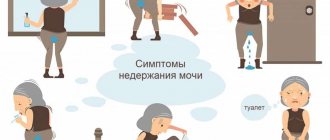Pain with cystitis in women signals the development of inflammation.
The severity of the disease and the possible development of complications are eloquently indicated by the localization of unpleasant sensations.
What to focus on when experiencing pain due to cystitis?
How to relieve pain, what medications or folk remedies will help eliminate the symptoms?
Let's look at all this in detail.
Why does the lower back, kidneys or lower abdomen hurt with cystitis?
Cystitis is an infectious and inflammatory disease of the genitourinary tract and the mucous membrane of the bladder.
The specific anatomy of the female body makes it more susceptible to this disease.
Since the urethra in women is wide and short (only 3-4 centimeters), which facilitates the penetration of infection.
Pain in men can also be piercing, but in percentage terms the incidence of cystitis is about 0.5%, and in women it is about 25%.
The cause of the disease can be bacterial microorganisms (Escherichia coli, Staphylococcus aureus), which is facilitated by:
- hypothermia (causes stress and reduces immunity, so bacteria multiply faster)
- neglect of basic personal hygiene laws
- stagnation of blood in the pelvis
- excessive sexual activity
- inflammatory processes in nearby organs
- injury to the bladder mucosa
- hormonal disorders
- constant stress and lack of vitamins
Cystitis is usually caused by an infection in the urine.
Pathogenic bacteria enter it from the intestines.
Based on the type of pathogen, cystitis is divided into bacterial and non-bacterial .
60% of all urinary tract infections occur after sex.
This is always a risk factor.
“Tormented by hellish pain” - this is how ladies who got their feet wet or became hypothermic in nylon tights in winter often characterize their condition.
The root cause of the malaise is the inflammatory process occurring in the mucous membrane of the bladder.
With cystitis, swelling forms, the swollen tissues put pressure on the nerve endings and give rise to excruciating cutting pain.
Its location will tell you where the epicenter of inflammation is.
Blog
A lot has been said and written about cystitis. But few people talk about the connection between cystitis and gynecological diseases - colpitis, candidiasis, sexually transmitted infections, etc. This article draws connections between these issues.
Cystitis is the most common urological disease among women. To one degree or another, signs of cystitis are observed at least once in a lifetime in more than half of women. For some, cystitis becomes an annoying nuisance, for others it turns life into hell, which, unfortunately, is not uncommon. We can safely say that cystitis is not “lucky”: this disease is at the intersection of two specialties - urology and gynecology. Inflammation of the bladder itself is a urological problem, and the reason that in most cases leads to the development of cystitis - a violation of the vaginal microflora - is a gynecological problem. It turns out that with a competent approach, a woman with cystitis should be treated by two doctors at once - a urologist and a gynecologist. But life shows that most often the problem of cystitis is dealt with by a gynecologist.
WHAT IS CYSTITIS?
Cystitis is an inflammation of the mucous membrane of the bladder. There are toxic, allergic, non-infectious cystitis - all these are rare and we will not talk about them. In the vast majority of cases, cystitis is caused by one or another infection. Most often this is one of the representatives of opportunistic flora - E. coli, staphylococci, streptococci, etc. Often there are cystitis directly associated with sexually transmitted infections, for example: ureaplasma, mycoplasma, chlamydia, gonorrhea. The infection enters the woman's bladder from the urethra. In women, it is short, wide, and it is very easy for bacteria to get through it. Bacteria most often enter the urethra from the vagina. Cystitis is almost always associated with inflammation of the vagina - colpitis, or a disturbance of the vaginal microflora - bacterial vaginosis. Traditionally, exacerbations of cystitis are associated with hypothermia. Yes, indeed, hypothermia causes a decrease in the body's resistance, especially the local immune response, as a result of which the infection actively multiplies and enters the bladder, causing an inflammatory reaction - cystitis. However, practice shows that cystitis is more often associated with particularly violent sexual intercourse. Sometimes exacerbations of cystitis are associated with the menstrual cycle.
“HONEYMOON” CYSTITIS
This beautiful term implies the development of signs of cystitis after defloration, that is, deprivation of virginity. The following happens. Even before a girl begins sexual activity, she may have disturbances in the vaginal microflora. This happens all the time; thrush in girls is so common that it is considered almost the norm. The first sexual intercourse is not always violent, but it is still accompanied by an abundant flow of vaginal microflora into the urethra and bladder. Their walls are not prepared for such an attack, and an inflammatory reaction develops, that is, cystitis. It’s rare that someone gives up sex on their honeymoon, even despite illness. Therefore, cystitis progresses and progresses...
SYMPTOMS OF CYSTITIS
Cystitis is manifested primarily by increased urination. At the same time, the woman constantly has a strong urge to visit the toilet, which does not correspond to the amount of urine released. Often a woman notices pain at the end of urination, sometimes blood appears in the urine. With acute cystitis, the temperature rises and pain appears in the lower abdomen. If the so-called cervical form of cystitis develops, in which the bladder sphincter is involved in the inflammatory process, then episodes of urinary incontinence are observed. Cystitis should not be confused with urethritis - inflammation of the urethra. Urethritis is manifested by unpleasant sensations, pain, burning or stinging when urinating - and nothing more. Cystitis and urethritis often accompany each other, but this is not always the case.
WHAT DO MANY WOMEN DO?
Most often, at the first symptoms of cystitis, on the advice of more “experienced” friends, the girl takes several tablets of the first antibiotic she comes across, the symptoms of the disease subside and they forget about it until the next exacerbation. This can go on for years. Unfortunately, some doctors do no better in this situation. The urologist at the district clinic will do a general urine test, after which he will prescribe some kind of uroseptic. A few days pass, the symptoms of cystitis decrease, and everything is fine. Nobody thinks about why cystitis worsened and how to prevent it. However, exacerbations of cystitis occur again and again. A woman is forced to wrap herself in warm clothes even in the heat, always think about what she can eat and what she cannot, and fear every intimacy with her loved one. This state of affairs can drive you crazy...
CAUSES OF CYSTITIS:
As already noted, in the vast majority of cases, the development of cystitis is associated with an infection in the vagina. Normally, a woman’s vagina is inhabited by microflora. It is based on the so-called lactobacilli, or Dederlein bacilli; there are also a small number of bifidobacteria and some other microorganisms. All these microbes are in ecological balance, their numbers are strictly controlled by each other, and they do not allow any other microorganism to appear in the vagina. Under the influence of various factors, this balance may be disrupted. These factors are varied - from stress and hypothermia to hormonal changes, pregnancy or withdrawal of oral contraceptives. An imbalance occurs when colonies of some microorganisms grow in large quantities and suppress all others. These may be fungi of the genus Candida, and the resulting disease will be called vaginal candidiasis, or simply “thrush”. It could be gardnerella - then the disease will be called gardnerellosis (bacterial vaginosis). It could be some kind of sexually transmitted infection - ureaplasmosis, trichomoniasis, chlamydia. These can be almost any microorganisms that have pathogenic activity. Vaginal dysbiosis is often accompanied by intestinal dysbiosis. Manifestations of bacterial vaginosis And so, a violation of the vaginal microflora has occurred. Classic symptoms for this disease are burning and itching in the genitals, copious mucous discharge, sometimes with an unpleasant odor, dryness and discomfort during sexual intercourse. These symptoms can be expressed to varying degrees, from very strong to subtle. In addition, bacterial vaginosis is a chronic disease and occurs with periods of exacerbations and remissions. If a microflora disorder was previously noted, then exacerbations occur periodically. From bacterial vaginosis there is only one step left to vaginitis, or colpitis - inflammation of the vagina. With this disease, the discharge begins to be purulent in nature, pain and pain appear in the genitals, and sometimes the body temperature rises. In the same way, one step remains to cervicitis - inflammation of the cervix (pain in the lower abdomen, painful sexual intercourse), urethritis - inflammation of the urethra (pain and burning when urinating). Very close to cystitis.
COMPLICATIONS OF CYSTITIS
Over a long period of time, the infection from the bladder enters the kidneys, which can lead to the development of pyelonephritis - inflammation of the kidney tissue. This is manifested by high fever and lower back pain on one side. Rarely, pyelonephritis is bilateral, and this situation is already life-threatening. Pyelonephritis, as a rule, is treated seriously, often in a hospital, with careful diagnosis and massive therapy. But even here, no one is engaged in the full treatment of cystitis and restoration of vaginal microflora. As a result, the disease will recur, and with each new attack of pyelonephritis, kidney function decreases. As a result, a woman may become disabled.
Now let's talk about the worst part. With some individual features of the structure of the bladder wall, the inflammatory process spreads to its entire thickness, affecting not only the mucous membrane, as with ordinary cystitis, but also the submucosal layer and the muscular wall of the bladder. This type of cystitis is called interstitial cystitis. Interstitial cystitis has several distinctive features. Such patients urinate frequently, up to 100-150 times a day. There may be pain in the lower abdomen, painful urination, and increased body temperature. Interstitial cystitis is practically untreatable. Sometimes antibiotics make things a little better, but more often they have no effect or cause the condition to worsen. With a long course of such cystitis, the muscle tissue of the bladder wall degenerates into rough scar tissue, the bladder loses its elasticity and decreases in volume. When the bladder volume reaches 50 ml, the only real treatment is surgery - complete removal of the bladder and its plastic from the area of the colon. Every woman who regularly notices exacerbations of cystitis and does not seriously treat it has a chance of developing interstitial cystitis.
CYSTITIS AND PREGNANCY
If a woman suffers from chronic cystitis, it is very likely that another exacerbation will occur during pregnancy. During pregnancy, the hormonal background of the body changes, the disturbance of the vaginal microflora most often worsens, the body's immunity decreases - all this creates conditions for the exacerbation of cystitis.
CYSTITIS AND SEXUAL INFECTIONS
Sexual infections include gonococcus, chlamydia, trichomonas, mycoplasma, ureaplasma, etc. All these pathogens can enter a woman’s vagina during sexual intercourse. Some time after entry, they cause inflammation of the vagina - colpitis, inflammation of the cervix - cervicitis, inflammation of the urethra - urethritis, which leads to disruption of the vaginal microflora - bacterial vaginosis. It often happens that the symptoms of the disease are so insignificant that the woman does not attach any importance to them, especially since after a few days they sometimes go away without treatment. Meanwhile, inflammation or disruption of the microflora becomes chronic, causing, among other things, a decrease in the body’s local immunity. By multiplying in the vagina, genital infections can themselves cause cystitis, but most often, against the background of a decrease in general and local immunity, nonspecific flora enters the bladder, causing exacerbation of cystitis. Therefore, direct or indirect, there is always a connection between sexually transmitted infections and cystitis. And competent treatment in this case should be carried out simultaneously with sexually transmitted infections and cystitis in one course, and at the same time treating the sexual partner.
CYSTITIS IN MEN
In men, cystitis does not occur often and almost always appears against the background of exacerbation of chronic prostatitis. More often, these symptoms are not too pronounced, and with treatment of inflammation of the prostate gland they go away on their own, without requiring additional measures. In other cases, a course of properly administered treatment for cystitis is usually effective. Only the problem of interstitial cystitis for men is almost the same as for women. In this case, surgical treatment is almost always necessary.
CYSTITIS IN CHILDREN
In children, for a number of reasons, cystitis develops quite often. The incidence of the disease is practically unrelated to either age or gender. In teenage girls, cystitis is more often associated with vaginal dysbiosis; in boys, cystitis often develops with phimosis (narrowing of the foreskin), but most often cystitis develops episodically, against the background of an accidental infection in the bladder. Fundamentally, the treatment of cystitis in children does not differ from the treatment of adults. Competent diagnosis necessarily includes a general analysis and urine culture, DNA tests for major infections, which make it possible to identify the pathogen and determine its properties. Cystitis in children very easily spreads to the kidneys, so it is better not to delay treatment, and cystitis must be taken very seriously.
TREATMENT OF CYSTITIS
For acute cystitis, treatment consists of prescribing special medications and bed rest. It is necessary to consume as much liquid as possible and exclude spicy and salty foods, seasonings, sauces, and canned food. Vegetables and fruits, dairy products are recommended.
When treating chronic cystitis, you should start by identifying the causes that led to inflammation. Treatment of cystitis in this case comes down to restoring urodynamics, eliminating foci of reinfection, and removing urinary stones. Antibacterial treatment is also carried out, but only after special examinations. In order to improve blood supply to the walls of the bladder, UHF, mud applications and inductothermy are prescribed.
The causes of cystitis are always individual, so self-medication and refusing to go to the doctor is very dangerous. The selection of medications for the treatment of cystitis should be carried out only by a doctor. Specialists of the diagnostic and treatment center “Dzhalin” LLC with a high degree of accuracy determine the causes of the development of cystitis and its causative agents, using the wide capabilities of modern diagnostic equipment, which is equipped in the urological office of our medical center. The high qualifications of our doctors allow us to exclude cases of medical error.
Urologist-andrologist Vladimir Safronov
How cystitis hurts: types of pain
Where exactly pain occurs with cystitis depends on the location of the inflammation and the specifics of the development of complications.
As a rule, with cystitis, women complain of pain in:
- in the lower abdomen
- lower back
- right or left side
To make an accurate diagnosis, it is necessary to determine where and what kind of pain the patient experiences with cystitis.
It happens that they are confused with manifestations of appendicitis, pyelonephritis or intestinal inflammation.
The sooner you visit the doctor's office, the sooner a diagnosis will be made and adequate treatment will be prescribed.
Lower back pain due to cystitis
Localization indicates that the inflammation has affected organs adjacent to the bladder, including the kidneys.
Sometimes with cystitis, the pain “radiates” to the lower back and sacrum due to compression of the nerve endings.
Contact your doctor immediately if:
- Unpleasant sensations intensify - this is one of the most common features of cystitis.
- The temperature rises above 38 degrees. With cystitis, your head and throat may hurt.
- The pain becomes “girdling.”
- Pain occurs when urinating - cystitis rarely occurs without this symptom.
- There is a feeling of weakness, in severe cases - nausea, vomiting.
To eliminate the risk of developing kidney damage, make an appointment with a nephrologist.
A comprehensive examination will be required if you are experiencing back pain.
They can also be a signal of kidney problems, as well as the presence of other infections.
Based on laboratory tests, the doctor prescribes:
- etiotropic therapy (drugs acting on the cause of the disease (nolicin, furagin, biseptol, nitroxoline);
- symptomatic therapy (if there is an elevated temperature - antipyretics, if there is pain - painkillers and antispasmodics; anti-inflammatory drugs (canephron - combines antibacterial and anti-inflammatory effects, has a diuretic property), the use of herbal teas.
- at normal body temperature - taking warm baths, using a heating pad to relieve pain.
The chronic course of the disease requires longer treatment. In severe cases, hospitalization is indicated.
Kidneys hurt with cystitis
The kidneys are an element of the urinary system.
They have an inextricable connection with the bladder.
If you ignore treatment or choose the wrong therapy, inflammation and acute pain with cystitis go up and reach the kidneys.
Intervention of infected microflora into the sterile internal space of this organ causes an active inflammatory reaction.
In addition, severe pain in the kidneys with cystitis can warn of the development of pyelonephritis.
Etiology of cystitis
The disease mainly occurs in females than in males. In women, the urethra is larger and shorter, making it easier for infections to enter. The causative agents of the diseases are staphylococci, Proteus, streptococci, E. coli, chlamydia, fungi, Trichomonas and others. Sometimes cystitis can occur after surgical or instrumental interventions. Cystitis can occur more than once and become chronic if treated incorrectly. In men, cystitis is rare and can only occur after procedures such as catheterization. Infection of the bladder is possible due to inflammatory processes in the prostate gland, testicles, and seminal vesicles.
With cystitis, the stomach hurts, like during menstruation
Pain in the lower abdomen is natural for cystitis, because this is where the bladder is located.
Many women compare them to the sensations during menstruation.
An irritated bladder presses on nerve endings and provokes frequent attacks.
The nature of pain with cystitis can be:
- aching
- cramping
- pulling
- cutting
- sharp
- radiating to the groin
When the bladder is full, the pain may intensify.
If cystitis is accompanied by constant pain in the lower abdomen, it is recommended to check the condition of the uterus.
Symptoms of cystitis
- Frequent urination - the sick person runs to the toilet very often, about 40 times a day.
- Pain when urinating - the patient experiences pain when urinating. The pain can be very severe. When the process of urination is completed, the patient feels a pain. There may be nagging, cramping pain in the abdomen and lower back.
- A pungent odor of urine, a change in the color of urine - the patient’s urine becomes cloudy and there is sediment in it. The smell of urine becomes extremely unpleasant; in the acute phase of the disease, blood and pus can be found in the urine. Blood in the urine is a more serious symptom of the disease.
- Increased body temperature - the patient experiences a fever of up to 38-39 degrees. Without etiotropic treatment, antipyretic drugs have almost no effect. The temperature drops a little and then rises again.
Pain in the right or left side
If you suspect you have cystitis, pay attention to whether your side hurts - right or left.
In the first case, painful sensitivity may indicate not only inflammation of the mucous membrane of the bladder, but also inflammation of the appendages, volvulus, aggravated ulcers, appendicitis, and bowel dysfunction.
Pain in the left side can warn of inflammation of the kidneys or appendages.
Be sure to get tested and undergo an ultrasound examination.
Types of cystitis
- Acute cystitis - occurs suddenly and is manifested by frequent and painful urination. The patient also experiences pain in the lower abdomen and blood in the urine. The duration of the acute course of the disease is 1 week, sometimes 10-15 days.
- Chronic cystitis occurs if no therapeutic measures are taken for acute cystitis, or the start of treatment is delayed. Symptoms are milder than those of an acute process.
- Allergic cystitis - occurs due to allergens entering the body, which provoke the walls of the bladder. Allergens can be cosmetics, food, medicines, and household chemicals. The symptoms of the disease are the same.
- Hemorrhagic cystitis - develops as a result of inflammation of the bladder, and can be accompanied by a bacterial infection. This form of cystitis is characterized by frequent false urge to urinate and little urine. A blood test reveals blood, this is due to trauma to the mucous membrane of the bladder.
- Chemical cystitis - occurs from the influence of a toxic substance that has entered the mucous membrane of the bladder. This is a consequence of improper treatment. This species occurs quite rarely.
Painful urination due to cystitis
Do you experience pain when urinating with cystitis?
It is associated with the peculiarities of the development of this disease in women.
Penetrating into the bladder, pathogenic microflora climbs up the urethra.
The short and wide urinary canal becomes inflamed, so urine moving through it causes irritation and burning.
This kind of pain is characteristic not only of cystitis, but also of urethritis.
This disease can be distinguished by several signs:
- general health and body temperature are within normal limits
- painful sensations have a clear localization, they do not respond in other organs
- urine does not acquire an unusual odor, but even in this case, discharge mixed with blood or pus is possible
Pain with cystitis
Pain due to cystitis is quite common, but it is expressed differently in each person. The pain can be intense or weak, pulling, stabbing or cutting in nature, periodic or constant. In addition, painful sensations in the lower abdomen and behind the pubis can signal various diseases. In this material we will talk about the painful sensations of cystitis.
Cystitis most often accompanies pain when urinating. It can be acute or dull, sometimes manifesting itself as a tingling or stretching sensation. Severe pain with cystitis is possible during an acute inflammatory process. Conversely, cystitis without pain when urinating is characteristic of a chronic disease.
Patients suffering from symptoms resembling cystitis often ask the question: what hurts with cystitis?
As a rule, with cystitis, the lower abdomen hurts, especially in the suprapubic region. As mentioned above, the nature of sensations varies. The duration of pain is intermittent or constant, and usually painful symptoms accompany the process of filling the bladder. In acute urethritis accompanying cystitis, pain occurs directly during urination and is accompanied by the following symptoms:
- feeling of cutting, burning;
- general malaise;
- rise in body temperature;
- changes in the transparency of excreted urine; urine may not only be cloudy, but also contain blood and mucous-bloody inclusions.
It is worth noting that pain due to cystitis is characterized by so-called irradiation: the spread of pain to the skin of the external genitalia, groin, and inner thigh. Patients describe these sensations as “shooting pain.”
Thus, abdominal pain with cystitis is localized in the lower sections. But people suffering from cystitis wonder: why do their sides hurt with cystitis? A symptom such as the appearance of pain in the lateral parts of the abdomen should certainly alert you. The fact is that the progression of the inflammatory process in the bladder is dangerous due to the development of an ascending infection, the transition of inflammation to the kidney tissue with the formation of pyelonephritis. With this complication, the pyelocaliceal apparatus of the kidneys is affected. With complicated cystitis, the kidneys really hurt, and the pain is localized in the lateral abdomen, as well as in the lumbar region. During the examination, the doctor will determine Pasternatsky’s characteristic symptom - pain when tapping on the lower back. Often pyelonephritis is accompanied by deterioration of the condition, a rise in body temperature; There may be nausea and vomiting.
Pain with cystitis is not always pronounced, given the prevalence of chronic forms of the disease. Therefore, you should be more attentive to your own feelings in order to prevent the progression of the disease. Early consultation with a doctor is necessary to prevent possible complications.
Doctor of the Private Practice clinic, dermatovenerologist, urologist Nikitin A.O. talks about cystitis.
Pain due to cystitis during pregnancy
This disease worsens during pregnancy.
A weakened immune system is not able to fight off pathogenic microflora, therefore there is a risk of pyelonephritis.
In addition, cystitis, which rarely occurs without pain, can cause uterine tone and training contractions.
Signs that a pregnant woman has had to deal with bladder inflammation:
- Repeated and painful urination. False calls.
- Minor urine output even with a full bladder.
- Change in urine color. Cystitis provokes not only pain, but also the presence of blood or mucus in the urine.
- Discharge with an unpleasant odor, which indicates the threat of purulent inflammation, which is extremely dangerous during pregnancy.
Cystitis can negatively affect pregnancy and the development of the baby.
Treatment tactics are determined after receiving test results.
The final diagnosis is made by a urologist and obstetrician-gynecologist.
Treatment in this case is prescribed taking into account the sensitivity of antibiotics from those groups that are approved for use in pregnant women.
To do this, bacterial culture of urine is mandatory.
If the manifestations of cystitis are very active, one of the broad-spectrum antibiotics in combination with uroseptics is prescribed.
With cystitis, the ovaries hurt
This is a sign of progression of the disease and the appearance of complications in the reproductive system.
You should not look for pills to relieve pain from cystitis on your own.
Self-medication may make the situation worse.
Visit a gynecologist who will make a diagnosis and select treatment.
A dangerous complication of cystitis is infertility.
To eliminate this problem, an integrated approach is required, including urological therapy and treatment of gynecological diseases.
Often, specialists resort to medications and physiotherapy, and as a supplement they prescribe herbal medicine and homeopathic medicines.
Legs hurt with cystitis
This is an indirect sign of cystitis, accompanied by swelling.
Edema is a consequence of fluid retention in the body, which may indicate the development of an inflammatory process in the bladder and kidneys.
Comprehensive treatment is necessary to eliminate the symptoms of the disease, after which the pain in the legs, as a rule, goes away on its own.
In some cases, leg pain is a sign of kidney complications and chronic cystitis.
It is recommended to increase the amount of fluid consumed (pure water without gas) per day to speed up the elimination of toxins and adhere to a nutritious diet.
Eliminate spicy, fatty, smoked and salty foods from your diet.
Fruit drinks, freshly squeezed juices and herbal decoctions will be useful.
Do physical exercises to normalize blood circulation.
After a series of squats and bends, rest in a lying position, throwing your legs over the back of the sofa or wall.
This will help cope with spasms and eliminate pain.
After 20-30 minutes, take a not too hot bath to warm up the tissues and improve metabolic processes.
With cystitis, the clitoris hurts
This phenomenon occurs frequently and is explained by the fact that the clitoris is one of the most sensitive parts of the female body.
There are a lot of nerve endings connected to the clitoris, so even small deviations and barely begun inflammatory processes can be accompanied by pain.
If you have pain in the groin, this may also be a symptom of cystitis.
But the range of reasons that cause discomfort in this area is too wide.
To make a correct diagnosis and prescribe treatment, you must seek the help of a doctor.
Risk factors predisposing to the development of cystitis
- Hypothermia of the body - if you sit on something cold, dress lightly in cool weather, swim in cool water;
- Insufficient consumption of plain water;
- Eating spicy, fried, salty, sour, spicy foods;
- Drinking large amounts of alcohol;
- Chronic foci of infection (chronic tonsillitis, carious teeth, frequent sore throats);
- Wiping with toilet paper from the anus to the vagina, this applies to the female sex;
- Sedentary lifestyle;
- Irregular or, conversely, too vigorous sex life;
- Promiscuous sexual intercourse leading to STDs;
- Rare visits to the gynecologist;
- Prolonged abstinence from urination;
- Constipation.
Pain during sex: how to recognize cystitis
In the presence of cystitis, sexual intercourse may be accompanied by pain in both men and women.
After sex, there is an unexpected urgent urge to urinate and a burning sensation.
A heating pad applied to the perineum will help temporarily relieve symptoms.
But cystitis must be treated so that the pain does not become chronic.
After an examination, for which a urine test is taken (general and Nechiporenko), urine culture for pathogenic flora, a smear for sexually transmitted infections, an ultrasound of the kidneys is done, and treatment is prescribed.
Most often, doctors advise suspending sexual activity during this period.
Since sexual intercourse further irritates the mucous membrane, symptoms intensify and recovery is significantly delayed.
Cystitis is not a contagious disease and is not sexually transmitted.
At the end of taking antibiotics, you can have sex, but without stopping treatment.
How to relieve pain from cystitis at home
Cystitis cannot be tolerated.
This disease requires immediate treatment - competent and comprehensive, and not just muffling the symptoms.
To prevent cystitis from developing into frequent cystitis, you must strictly follow your doctor’s advice on the dosage and frequency of taking prescribed medications.
You should not abandon therapy as soon as the pain after cystitis stops.
Otherwise, the effectiveness of treatment is low.
The bacteria will become immune to the therapy and will soon reassert themselves.
Many people are interested in how long it takes for the pain to go away after starting treatment for cystitis.
The answer to this question depends on the characteristics of the disease, but with the right approach, the discomfort will disappear after 3-4 days.
However, you need to know how to relieve the pain of cystitis if for some reason a trip to the clinic is postponed.
Quick results are provided by analgesics - drugs that relieve pain of any type, including those that radiate to the spine, lower back or groin area.
What to drink if it hurts, like with cystitis?
Choose one of the common analgesics - No-Shpu, Nise, Papaverine or Spazmalgon.
Suspensions and suppositories are indicated for pain relief directly at the site of inflammation, but they are not popular.
Remember that painkillers do not fight the original source of pain, but only stop the attack.
If you take too many analgesics, you risk causing irreversible changes in your body’s functioning.
You should not “Google” traditional methods of treating cystitis.
The vast majority of them are unscientific, unexplored and simply dangerous, because they were used long before the latest medical techniques appeared.
It is also not recommended to take “healing” herbs uncontrollably.
Plants contain useful active components, but it is impossible to calculate their dose, which is fraught with side effects.
If during the consultation the doctor recommends a certain medicine (bearberry decoction or cranberry juice, for example), he will tell you how to take it in combination with an antibiotic, antispasmodics, and diuretics.









